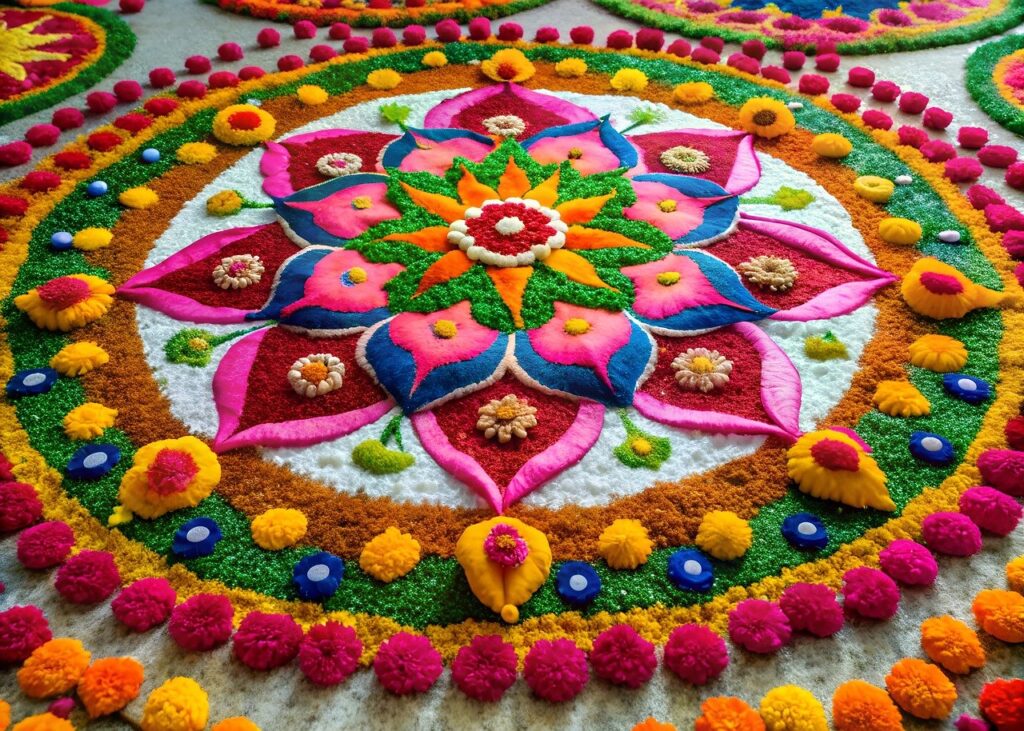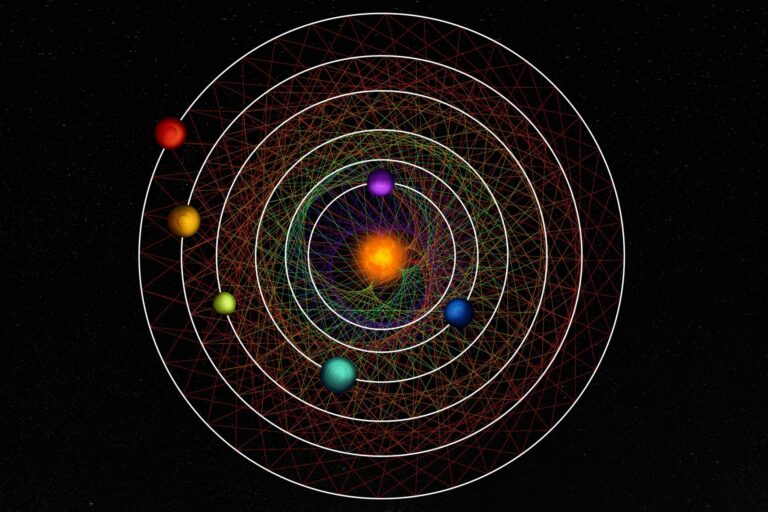Rangoli and the Mathematics of Symmetry: Celebrating Diwali with Art and Maths

Diwali, the festival of lights, is celebrated with vibrant lights, sweets, and the art of Rangoli. Rangoli, a beautiful tradition in Indian culture, involves creating intricate, colorful patterns at entrances to homes, symbolizing good luck and prosperity. But there’s more to Rangoli than meets the eye – it’s also an excellent example of mathematics at work, particularly in the concepts of symmetry and geometry.
In this article, we’ll explore the science and math behind Rangoli patterns, uncovering the fascinating ways that geometry and symmetry are naturally embedded in these traditional designs.
What is Rangoli?
Rangoli is a folk art form in India where patterns are created using materials such as colored rice, dry flour, colored sand, or flower petals. It is typically drawn on the floor at entrances of homes, especially during festivals like Diwali, to invite positivity and ward off negativity.
While Rangoli is an art form, its patterns are often based on symmetrical designs that make it visually appealing and harmonious.
Symmetry in Rangoli: The Mathematical Beauty of Balance
Symmetry is a key element in most Rangoli patterns, adding balance and rhythm to the designs. In mathematical terms, symmetry is when a figure or object can be divided into two identical halves that mirror each other. There are different types of symmetry often seen in Rangoli patterns:
1. Reflective (or Mirror) Symmetry
Reflective symmetry occurs when one half of a pattern reflects the other, like a mirror image. For example, a Rangoli design may have a central axis, and patterns on one side of this axis are identical to the other. This is one of the most common symmetries used in Rangoli because it gives the design a sense of order and beauty.
2. Rotational Symmetry
In rotational symmetry, a design looks the same after being rotated around a central point by a certain angle. For instance, some Rangoli designs may involve patterns that repeat every 90 or 120 degrees. Rotational symmetry is popular because it allows for more intricate and dynamic designs that still feel balanced.
3. Translational Symmetry
This symmetry involves repeating patterns that are shifted or moved in a specific direction. Translational symmetry in Rangoli could be seen in a series of identical shapes or patterns repeated in a straight line or circular path.
By applying these types of symmetry, Rangoli artists create designs that are both visually harmonious and mathematically intriguing.
Geometry in Rangoli: Shapes and Patterns
In addition to symmetry, geometry plays a significant role in Rangoli. Basic shapes like circles, squares, triangles, and polygons form the foundation of many Rangoli patterns. Here’s how different geometric shapes are commonly used:
• Circles: Representing continuity and unity, circles are commonly used in Rangoli. Concentric circles are often drawn as a base layer, with more complex shapes and colors added within each ring.
• Triangles: Triangles, symbolizing strength and stability, are frequently used in Rangoli. They can appear in a star-like arrangement or with alternating colors to add vibrancy.
• Polygons: Regular polygons, like hexagons and octagons, add variety to Rangoli. Artists use these shapes to create a cohesive and structured pattern that reflects mathematical precision.
These geometric elements aren’t just decorative; they illustrate the fundamental principles of geometry and create a visually appealing arrangement.
Fractals and Rangoli: A Connection to Complex Patterns
Fractals are intricate patterns that repeat at various scales and are often seen in nature. Some Rangoli designs mimic fractal patterns, where smaller versions of a shape or pattern are nested within a larger structure. This repetition of patterns at different scales is both beautiful and mathematically fascinating, making Rangoli a great example of how art and math intersect.
Creating Your Own Rangoli: A Step-by-Step Guide
Want to try your hand at Rangoli while exploring symmetry and geometry? Here’s a simple guide to get started with a symmetrical Rangoli design for Diwali:
1. Choose a Central Point: Start by marking the center of your Rangoli. This point will be your axis of symmetry or rotation.
2. Draw Basic Shapes: Begin with a large circle, square, or hexagon as your foundation. Use chalk or white powder to outline your design.
3. Add Symmetry: Create mirror images or rotate smaller shapes around the center. Add triangles, petals, or leaf shapes along the edges.
4. Fill with Color: Use colored powders, flower petals, or sand to fill in the patterns. Alternate colors symmetrically for a balanced look.
5. Perfect the Details: Small dots or lines can add complexity and fill empty spaces, enhancing the overall pattern.
Creating a Rangoli design is not only a fun activity but also a hands-on way to explore mathematical concepts.
Rangoli and Math in the Classroom
For students, creating Rangoli designs can be a fun way to learn about geometry, symmetry, and fractals. Teachers can introduce Rangoli patterns in math classes to demonstrate these concepts in a practical, engaging way. By combining cultural art with math, Rangoli offers a unique educational experience.
Conclusion: The Art and Math of Rangoli Patterns in Diwali Celebrations
Rangoli is more than just a decorative art form; it’s a mathematical expression of symmetry and geometry. Each Rangoli design reflects an intricate understanding of shapes and patterns, blending creativity with structure. This Diwali, as you marvel at Rangoli patterns, appreciate the hidden math that makes them so captivating and learn a bit more about the beauty of symmetry and geometry.





